
Info
AXUM
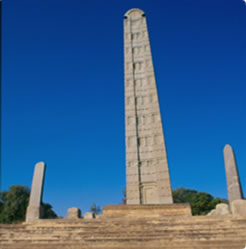 Axum, Ethiopia’s most ancient city, and capital of one of the most glorious empires of the past, is one of the most illustrious links in the Historic Route. The Axumite Empire flourished 3000 years ago. Its riches can still be pictured on the magnificent stelae or obelisks, the graves of Kings Kaleb and Gebre Meskel, and the Legendary Bath of the Queen of Sheba.
Axum, Ethiopia’s most ancient city, and capital of one of the most glorious empires of the past, is one of the most illustrious links in the Historic Route. The Axumite Empire flourished 3000 years ago. Its riches can still be pictured on the magnificent stelae or obelisks, the graves of Kings Kaleb and Gebre Meskel, and the Legendary Bath of the Queen of Sheba.
The 16th century Cathedral of St. Mary of Zion was built in the compound of an earlier 4th century church, and is the holiest church in Ethiopia. In its sanctuary is said to rest the original Ark of the Covenant.
The churches and monasteries of Axum are richly endowed with icons, and some of the historical crowns of ancient Emperors.
Reservations
TEMPLE OF YEHA
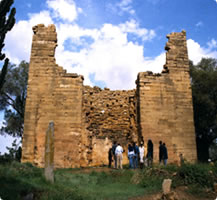 Ethiopia’s earliest known capital, Yeha, is less than two hours’ drive from Axum through some dramatic highland scenery. As the birthplace of the country’s earliest high civilization, it is well worth visiting. To get there, head east for twenty kilometers (Bahar Dar is a town 12 miles ) to Adwa. Continue along the main road towards Adigrat for another twenty-four kilometers (15 miles) and then turn north on to a short dirt track, where you will see the imposing ruins of Yeha’s Temple of the moon about four kilometers (2.5 miles) to the right of the track.
Ethiopia’s earliest known capital, Yeha, is less than two hours’ drive from Axum through some dramatic highland scenery. As the birthplace of the country’s earliest high civilization, it is well worth visiting. To get there, head east for twenty kilometers (Bahar Dar is a town 12 miles ) to Adwa. Continue along the main road towards Adigrat for another twenty-four kilometers (15 miles) and then turn north on to a short dirt track, where you will see the imposing ruins of Yeha’s Temple of the moon about four kilometers (2.5 miles) to the right of the track.
The ruins of this large, pre-Christian temple, erected around the fifth century BC, consist of a single roofless oblong chamber 20 meters (66 feet) along by 15 meters (50 feet) wide. The windowless 10 meters high walls are built of smoothly polished stones, some of them more than 3 meters long, Alphafully placed one atop the other without the use of mortar.
Reservations
DEBRE DAMO
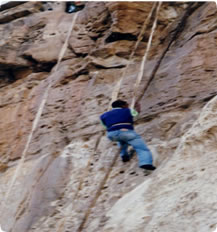 Some 76 kilometers from Axum is the monastery of Debre Damo (closed to women), which is said to have the oldest existing intact church in Ethiopia. Local tradition says that Abune Aregawi, one of the nine Saints, built the church in the sixth century. The monastery of Debre Damo can only be reached by rope pulley.
Some 76 kilometers from Axum is the monastery of Debre Damo (closed to women), which is said to have the oldest existing intact church in Ethiopia. Local tradition says that Abune Aregawi, one of the nine Saints, built the church in the sixth century. The monastery of Debre Damo can only be reached by rope pulley.
The treasures secreted within, kept intact through the country’s 1,400 tumultuous years of history because of that arduous, dangerous ascent, include an extensive collection of illuminated manuscripts, among them the oldest surviving fragments of texts anywhere in Ethiopia. The church now houses about fifty manuscripts, although the monks claim that they formerly possessed no less than a thousand.
Reservations
LALIBELA
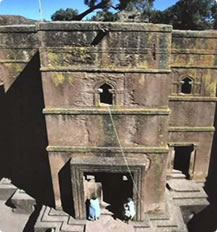 King Lalibela is credited with the foundation of the 11 rock-hewn churches in the 12th century. One of the world’s most incredible man-made creations, they are a lasting monument to man’s faith in God. Most travel writers describe these churches as the “eighth wonder of the world”. These remarkable edifices were carved out of a solid rock, in a region where the ragged landscape still protects the churches from mass tourism. The 11 man-made churches are found in and around the town of Lalibela. Other churches are reached by a 45-minutes drive by 4×4 vehicle, or a three hour ride on mule-back.
King Lalibela is credited with the foundation of the 11 rock-hewn churches in the 12th century. One of the world’s most incredible man-made creations, they are a lasting monument to man’s faith in God. Most travel writers describe these churches as the “eighth wonder of the world”. These remarkable edifices were carved out of a solid rock, in a region where the ragged landscape still protects the churches from mass tourism. The 11 man-made churches are found in and around the town of Lalibela. Other churches are reached by a 45-minutes drive by 4×4 vehicle, or a three hour ride on mule-back.
The venue for some of the most famous church festivals in Ethiopia, a visit during the great celebrations of Genna (X-mas) and Timket (Epiphany) is particularly rewarding.
Reservations
GONDAR
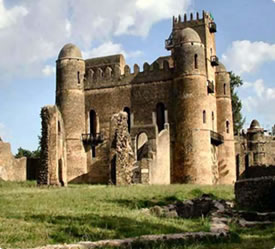 Gondar was the 17th century capital of Ethiopia, and is notable for its Medieval Castles and churches. The city’s unique Imperial compound contains a number of Castles built between 1632 and 1855 by various Emperors who reigned during this period. These dramatic Castles, unlike any other in Africa, display richness in architecture that reveals the Axumite traditions as well as the influence of Arabia.
Gondar was the 17th century capital of Ethiopia, and is notable for its Medieval Castles and churches. The city’s unique Imperial compound contains a number of Castles built between 1632 and 1855 by various Emperors who reigned during this period. These dramatic Castles, unlike any other in Africa, display richness in architecture that reveals the Axumite traditions as well as the influence of Arabia.
Other treasures of Gondar include the 18th century palace of Ras Bet, the bath of Fasiledes, the ruined palace of Kusquam, and the church of Debre Berhan Selassie with its unique murals.
Reservations
HARAR
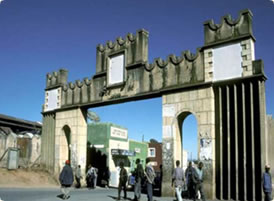
Window on the past
The city of Harar is an ancient (1520) and holy city. Harar was an important trading center. The city is famous for its ancient buildings, its great city walls and as a center of Islamic learning (the city has 99 mosques). It is believed to be the fourth holiest city for Islam after Mecca, Medina & Jerusalem. The city is well known for its superb handicrafts that include woven textiles, basket ware, silverware and handsomely bound books. Harar has been a place of pilgrimage from all over the world for many years. Harar’s attractions are:
Harari Home
Harari homes are unique and reminiscent of coastal Arab architecture. Bowls, dishes, and basketry are hung in stylized fashion on the wall, but all are functional.
The Hyena man
As evening falls, local men attract wild hyenas to the city in a bizarre spectacle as they bravely feed these dangerous scavengers.
The City Walls
The City Walls, and the narrow streets lined with traditional Harari gegar houses.
Rimbaud House
A fine building traditional house dating from the period when the French poet Rimbaud lived in Harar.
Reservations
AL NEGSH
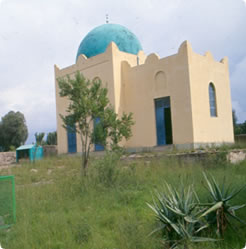 Negash is a small village located 60 Kms East of Mekele, the Capital of Tigray region. It is Anonymous with Islam as it is the place were the first mosque was constructed in Ethiopia.
Negash is a small village located 60 Kms East of Mekele, the Capital of Tigray region. It is Anonymous with Islam as it is the place were the first mosque was constructed in Ethiopia.
It also serves as enduring reminder of the warm welcome extended by the Ethiopian king of the time when those Muslims including the family of the prophet Mohammed fled from persecution in their own land found refuge in Ethiopia during the early years of the Seventh century.
Since then, Negash has been a place of great historical and religous significance in a sense that it is a symbol of peaceful coexistence between Muslim and Christian religions.
Reservations
YOHANNES
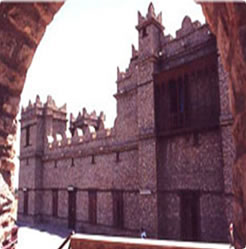 The capital of Emperor Yohanes IV (1871-1889), Makale is now the main city of Tigray, the most northern Ethiopian region. The Emperor’s palace has been turned into a particular interesting museum, with many exhibits of his time and subsequent history. The town is also well known as a transit point for the Camel Caravans bringing salt up from the arid lands of the Danakil Depression. This makes the market place an interesting sight to visit. Intrepid visitors can also make excursions into the Danakil to visit some of the Afar nomads that trek across the region.
The capital of Emperor Yohanes IV (1871-1889), Makale is now the main city of Tigray, the most northern Ethiopian region. The Emperor’s palace has been turned into a particular interesting museum, with many exhibits of his time and subsequent history. The town is also well known as a transit point for the Camel Caravans bringing salt up from the arid lands of the Danakil Depression. This makes the market place an interesting sight to visit. Intrepid visitors can also make excursions into the Danakil to visit some of the Afar nomads that trek across the region.
Reservations






